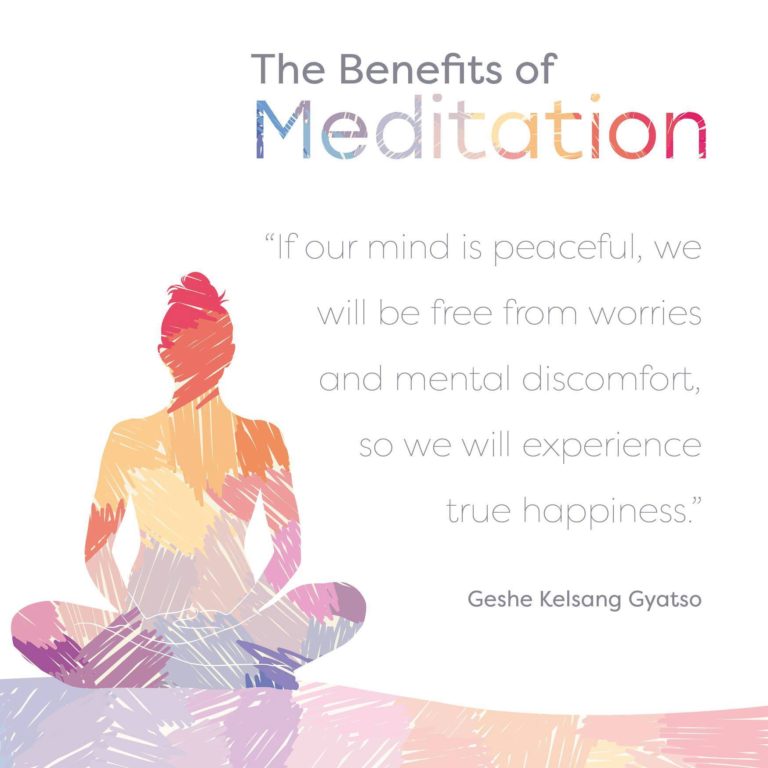
Meditation Techniques
What is meditation?
Meditation is a simple yet profound method to improve the quality of our lives and develop inner peace. Through following very simple, practical instructions we can learn how to let go of the causes of our pain and dissatisfaction and to gain the happiness and clarity we seek.The meditation practices that we teach are ways to control our mind and to develop a deep and lasting peace from within.
The following explanation of meditation is extracted from The New Meditation Handbook by Geshe Kelsang Gyatso:
“Meditation is a mind that concentrates on a virtuous object, and which is the main cause of mental peace. The practice of meditation is a method for acquainting our mind with virtue. The more familiar our mind is with virtue, the calmer and more peaceful it becomes. When our mind is peaceful, we are free from worries and mental discomfort, and we experience true happiness.
If we train our mind to become more peaceful we shall be happy all the time, even in the most adverse conditions; but if our mind is not peaceful, then even if we have the most pleasant external conditions we shall not be happy. Therefore, it is important to train our mind though meditation.
Whenever we meditate, we are performing an action that causes us to experience inner peace in the future. Day and night, throughout our life, we usually experience delusions, which are the opposite to mental peace. However, sometimes we naturally experience inner peace. This is because in our previous lives we concentrated on virtuous objects. A virtuous object is one that causes us to develop a peaceful mind when concentrating on it.
If we concentrate on an object that causes us to develop and unpeaceful mind, such as anger or attachment, this indicates that for us the object is non-virtuous. There are also many neutral objects that are neither virtuous nor non-virtuous.
Contemplation and meditation
There are two types of meditation: analytical meditation and placement meditation. Analytical meditation involves contemplating the meaning of a spiritual instruction that we have heard or read. By contemplating such instructions deeply, eventually we reach a definite conclusion or cause a specific virtuous mind to arise. This is the object of placement meditation. We the concentrate single-pointedly on this conclusion or virtuous mind for as long as possible to become deeply acquainted with it. This single pointed concentration is placement meditation.
Often, analytical meditation is called “contemplation” and placement meditation is called “meditation”. Placement meditation depends upon analytical meditation, and analytical meditation depends upon listening to or reading spiritual instructions.
Quoted from ‘New Meditation Handbook’, Geshe Kelsang Gyatso and the New Kadampa Tradition
The benefits of meditation
The purpose of meditation is to make our mind calm and peaceful. If our mind is peaceful we shall be free from worries and mental discomfort, and so we shall experience true happiness; but if our mind is not peaceful, we shall find it very difficult to be happy, even if we are living in the very best conditions.
If we train in meditation, our mind will gradually become more and more peaceful, and we shall experience a purer and purer form of happiness. Eventually we shall be able to stay happy all the time, even in the most difficult circumstances.
Usually we find it difficult to control our mind. It seems as if our mind is like a balloon in the wind – blown here and there by external circumstances. If things go well, our mind is happy, but if they go badly, it immediately becomes unhappy. For example, if we get what we want, such as a new possession, a new position, or a new partner, we become excited and cling to it tightly. However, since we cannot have everything we want, and since we shall inevitably be separated from the friends, position, and possessions we currently enjoy, this mental stickiness, or attachment, serves only to cause us pain.
On the other hand, if we do not get what we want, or if we lose something that we like, we become despondent or irritated. For example, if we are forced to work with a colleague whom we dislike, we shall probably become irritated and feel aggrieved, with the result that we shall be unable to work with him or her efficiently and our time at work will become stressful and unrewarding.
Such fluctuations of mood arise because we are too closely involve in the external situation. We are like a child making a sandcastle who is excited when it is first made, but who becomes upset when it is destroyed by the incoming tide.
Inner space and clarity
By training in meditation we create an inner space and clarity that enables us to control our mind regardless of the external circumstances. Gradually we develop mental equilibrium, a balanced mind that is happy all the time, rather than an unbalanced mind that oscillates between the extremes of excitement and despondency.
If we train in meditation systematically, eventually we shall be able to eradicate from our mind the delusions that are the causes of all our problems and suffering. In this way, we shall come to experience permanent inner peace. Then, day and night in life after life, we shall experience only peace and happiness.
At the beginning, even if our meditation does not seem to be going well, we should remember that simply by applying effort to training in meditation, we re creating the mental karma to experience inner peace in the future.
The happiness of this life and of our future lives depends upon the experience of inner peace, which in turn depends upon the mental action of meditation. Since inner peace is the source of all happiness, we can see how important meditation is.”
Quoted from ‘New Meditation Handbook’, Geshe Kelsang Gyatso and the New Kadampa Tradition
How to meditate
The first stage of meditation is to stop distractions and make our mind clearer and more lucid. This can be accomplished by practising a simple breathing meditation.
We choose a quiet place to meditate and sit in a comfortable position. We can sit in the traditional cross-legged posture or in any other position that is comfortable. If we wish, we can sit in a chair. The most important thing is to keep our back straight to prevent our mind from becoming sluggish or sleepy.
We sit with our eyes partially closed and turn our attention to our breathing. We breathe naturally, preferably through the nostrils, without attempting to control our breath, and we try to become aware of the sensation of the breath as it enters and leaves the nostrils. This sensation is our object of meditation. We should try to concentrate on it to the exclusion of everything else.
At first, our mind will be very busy, and we might even feel that the meditation is making our mind busier; but in reality we are just becoming more aware of how busy our mind actually is. There will be a great temptation to follow the different thoughts as they arise, but we should resist this and remain focused single-pointedly on the sensation of the breath.
If we discover that our mind has wandered and is following our thoughts, we should immediately return it to the breath. We should repeat this as many times as necessary until the mind settles on the breath.
We should train in this preliminary meditation until we gain some experience of it. However, if we want to attain permanent, unchanging inner peace, and if we want to become completely free from problems and suffering, we need to advance beyond simple breathing meditation to more practical forms of meditation, such as the cycle of twenty-one Lamrim meditations explained in The New Meditation Handbook.

